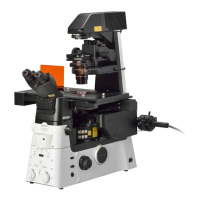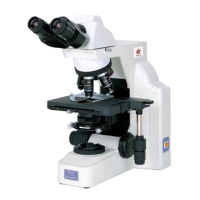Do you have a question about the Nikon Eclipse Series and is the answer not in the manual?
Explains symbols used in the manual for clarity and safety.
Details symbols indicating serious injury or property damage risks.
Provides critical warnings for intended use, disassembly, and manual adherence.
Outlines cautions for power handling, wet conditions, and assembly pinch points.
Emphasizes careful handling of the precision optical instrument.
Instructions to prevent dirt on lenses and mirrors for clear image viewing.
Specifies conditions for installing the instrument to ensure optimal performance.
Explains how accessories affect image brightness and advises consulting for compatibility.
Advises using the correct AC adapter for the pointer to prevent damage.
Notes potential interference with electronic devices and suggests placement.
Describes the setup for two observers positioned face-to-face.
Details the setup for two observers positioned side-by-side.
Explains the setup for two secondary observers viewing with a main observer.
Describes the setup for five observers sharing the view.
Details the setup for ten observers sharing the view.
Guides on correct microscope adjustment for secondary observer clarity.
Instructs on adjusting diopter settings for the secondary observer.
Explains simple diopter adjustment when a pointer is attached.
Details the operation and components of the pointer unit.
Step-by-step guide for assembling the dual-viewing (face-to-face) configuration.
Instructions for assembling the dual-viewing (side-by-side) configuration.
Guide for assembling the triple-viewing configuration.
Steps for assembling the 5-person multi-viewing configuration.
Instructions for assembling the 10-person multi-viewing configuration.
Details on how to mount the pointer accessory.
Provides detailed instructions for cleaning lenses and filters.
Guidance on cleaning painted parts without causing damage.
Recommendations for storing the instrument properly to prevent damage.
Advises on regular inspections for optimal performance.
Technical specifications for the Y-THP and Y-THPL pointer units.
Specifications for the AC adapters used with the pointer units.
Explains symbols used in the manual for clarity and safety.
Details symbols indicating serious injury or property damage risks.
Provides critical warnings for intended use, disassembly, and manual adherence.
Outlines cautions for power handling, wet conditions, and assembly pinch points.
Emphasizes careful handling of the precision optical instrument.
Instructions to prevent dirt on lenses and mirrors for clear image viewing.
Specifies conditions for installing the instrument to ensure optimal performance.
Explains how accessories affect image brightness and advises consulting for compatibility.
Advises using the correct AC adapter for the pointer to prevent damage.
Notes potential interference with electronic devices and suggests placement.
Describes the setup for two observers positioned face-to-face.
Details the setup for two observers positioned side-by-side.
Explains the setup for two secondary observers viewing with a main observer.
Describes the setup for five observers sharing the view.
Details the setup for ten observers sharing the view.
Guides on correct microscope adjustment for secondary observer clarity.
Instructs on adjusting diopter settings for the secondary observer.
Explains simple diopter adjustment when a pointer is attached.
Details the operation and components of the pointer unit.
Step-by-step guide for assembling the dual-viewing (face-to-face) configuration.
Instructions for assembling the dual-viewing (side-by-side) configuration.
Guide for assembling the triple-viewing configuration.
Steps for assembling the 5-person multi-viewing configuration.
Instructions for assembling the 10-person multi-viewing configuration.
Details on how to mount the pointer accessory.
Provides detailed instructions for cleaning lenses and filters.
Guidance on cleaning painted parts without causing damage.
Recommendations for storing the instrument properly to prevent damage.
Advises on regular inspections for optimal performance.
Technical specifications for the Y-THP and Y-THPL pointer units.
Specifications for the AC adapters used with the pointer units.
This document outlines the instructions for the Nikon ECLIPSE Series Teaching Head/Multi Teaching Head, an attachment designed to facilitate simultaneous microscopic observation by multiple users. It is compatible with various Nikon ECLIPSE microscope models, including Ni-E, Ni-U, Ci-E, Ci-S, Ci-L, 90i, 80i, 50i, E600W, E600, and E400.
The Teaching Head/Multi Teaching Head serves as an optical splitter, allowing a single microscopic image to be viewed by a main observer and one or more secondary observers simultaneously. This is particularly useful in educational settings, collaborative research, or training scenarios where multiple individuals need to observe the same specimen. The attachment is available in various configurations to accommodate different numbers of observers and viewing arrangements:
A key component of this system is the pointer unit, which allows an observer to highlight specific areas of interest within the field of view with an illuminated arrow. The pointer is available in two types: the Y-THP Pointer Unit with a built-in tungsten lamp and the Y-THPL LED Pointer Unit with a built-in LED.
To ensure optimal performance and a consistent viewing experience for all users, several steps are crucial:
Proper care and maintenance are essential to ensure the longevity and optimal performance of the Teaching Head/Multi Teaching Head.
| Objectives | Plan Achromat, Plan Fluor, Plan Apochromat |
|---|---|
| Objective Lenses | 4x, 10x, 20x, 40x, 100x |
| Magnification Range | 40x to 1000x |
| Eyepiece | 10x |
| Illumination | LED, Halogen |
| Observation Methods | Brightfield, Darkfield, Phase Contrast, Fluorescence |
| Focusing | Coarse and fine focusing |
| Stage | Mechanical stage |
| Condenser | Abbe condenser |
| Interpupillary Distance Adjustment | 48-75mm |
| Diopter Adjustment | Typically +/- 5 diopters |
| Power Supply | 100-240V AC |
| Nosepiece | Revolving nosepiece, typically with 5-7 objective positions |











